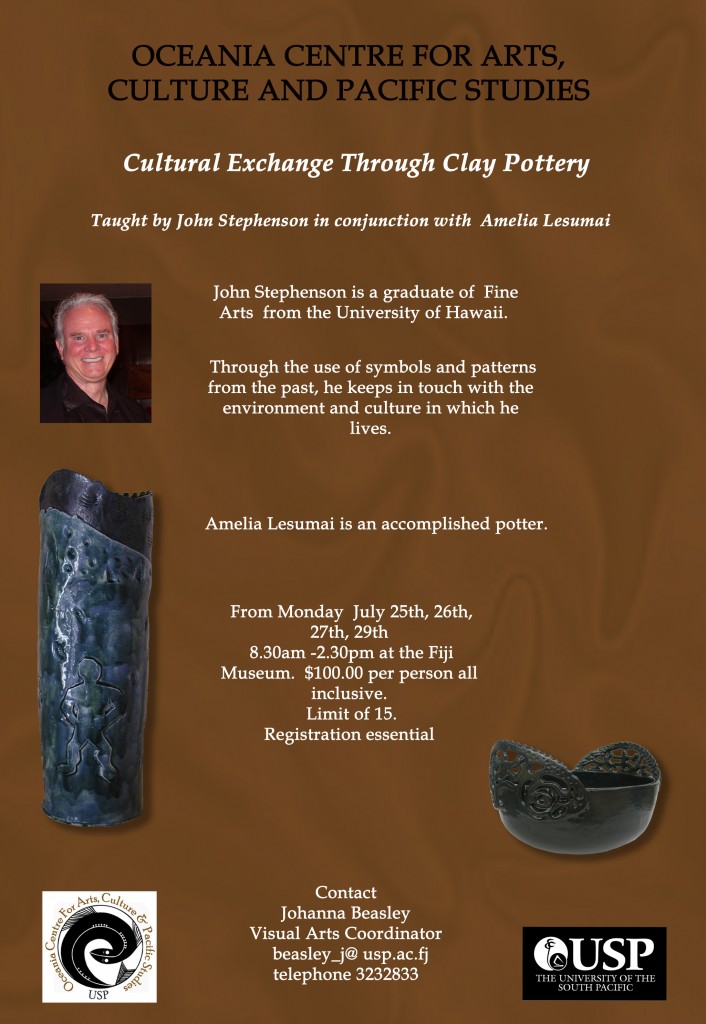 I was just thinking about the wonderful experience we had in Fiji a few years ago. I should have posted this at the time. Sharing my pottery techniques with a master native potter in Suva, Fiji was a fantastic experience. I learned so much. If you want to see our open pit firing there’s a video we did on YouTube. Here’s the address.
I was just thinking about the wonderful experience we had in Fiji a few years ago. I should have posted this at the time. Sharing my pottery techniques with a master native potter in Suva, Fiji was a fantastic experience. I learned so much. If you want to see our open pit firing there’s a video we did on YouTube. Here’s the address.
Category Archives: Paintings
Gallery 315
There’s a new gallery in Kailua showing original art. It’s been open a few months and shows work of primarily windward artists. It’s located on Ulunui Street, above Cinnamons Restaurant, right next to Manoa Chocolate. It’s a wonderful addition to Kailua Town.
Honolulu Museum of Art Show
June 14, 2012 – January 13, 2013
Honolulu Museum of Art
xhibition Overview
Featuring the work of
Joel Albanez • Tricia Allen • Bong • Mike Ledger • Keone Nunes • Lucky Olelo • Richie Lucero • Sado • Sua Suluape Toetuu, Aisea • Billy Whitney
Tattooing is art. After decades of being viewed as a mark of the marginal, tattoos have gone mainstream and are winning over the art establishment—including the Honolulu Museum of Art. The lines between ink on skin and paint on canvas or pencil on paper have been blurred with tattoo artists reaching the skill level of other artists. Now the Honolulu Museum of Art breaks new ground with an exhibition focusing on Hawai‘i’s high quality of tattoo art—and how it sprouted from the islands’ mix of cultures rich with tattoo traditions.
The museum is in the unique position to draw upon its world-class collection to place contemporary tattooing within an art historical context. By linking the past—through works such as 19th-century prints by Jacques Arago depicting tattooed Hawaiians—with the present, the museum hopes to expand cultural awareness not only about the art of the tattoo, but also the rich cultural traditions it is based on.
“Most artists believe that the basis of great art is drawing,” says Jost. “And tattoo artists in Hawai‘i are incredible draftsmen. They use this skill to create extraordinary tattoos. Add to that Polynesian, Asian, and military cultures, and the result is that Honolulu is now recognized as one of the world’s tattoo meccas. We are getting this recognition because the artists are great. It is a topic so vast, with so many cultural influences, that the entire museum curatorial staff is working as one team to create this exhibition.”
Home to the centuries-old Hawaiian kakau tradition, prototypical American tattoo artist Norman “Sailor Jerry” Collins, and the many tattoo traditions found in Japan and throughout Polynesia, Honolulu was destined to develop a corps of sought-after tattoo artists creating a visual language derived from all these cultures.
The exhibition presents 10 tattoo masters as contemporary artists, revealing their skills, ideas and sensibilities through photographs of the bodies on which they have drawn.
In addition, the exhibition highlights tattooing’s foundation of rich and diverse cultural traditions found in Hawai‘i today—Hawaiian, American, Japanese and Polynesian cultures will be featured. These smaller, focused galleries will link to works of art that are sources for Hawai‘i’s contemporary tattoo artists. For example, on view will be 19th-century Japanese woodblock prints that are the source of many contemporary tattoos. The curators also focus on military and mariner tattoo traditions, 18th-century western drawings depicting Pacific Islanders bearing tattoos, textiles and their rich link to Polynesian tattoos, and the specialized, beautiful tools used by the artists.
The exhibition reveals that the museum itself plays a part in tattoo culture—Japanese iconography tattoos created by O‘ahu artists are often based on works that can be found at the Honolulu Museum of Art. “At one Honolulu tattoo studio, we saw on a shelf books used as visual references and design inspiration—and they included the museum’s catalogue of Japanese prints from the Lane Collection. The tattooists didn’t even know that the original art was less than 10 blocks away,” says Jost.
“Because tattooing has not been considered part of the art historical canon,” says Jost, “the museum staff worked with many local experts and artists to understand the artform and learn firsthand how the apprenticeship system is alive and well in Honolulu, resulting in high-quality art. Our goal is to help these artists receive acclaim.”
One of those experts is part-time Honolulu resident Don Ed Hardy, who was a student of Sailor Jerry. Although now retired from tattooing, Hardy remains revered as a tattoo artist and has an encyclopedic knowledge of the history of tattoos.
This exhibition is supported by
The Atherton Family Foundation and Modern Luxury Hawai‘i
